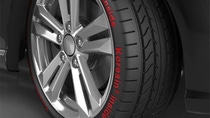Rubber Additives
Koresin keeps wheels turning
Koresin®, a phenolic resin that serves as a tackifier in tire production, has proved valuable for almost 80 years already - and is the benchmark for this product category even today.
At the 1936 international motor show staged in Berlin, noble automobiles were displayed sporting contemporary designs and high-gloss finishes. Yet many visitors had no eye for the elegant car bodies but instead gazed intently below the vehicle: for the first time, they were seeing tires made from Buna rubber, the synthetic rubber produced by I.G. Farbenindustrie AG, which at the time included BASF.
Researchers had worked meticulously for a long time, trying to invent a synthetic rubber that was to relieve the country from its dependence on natural rubber imports from overseas countries. At the end of the nineteen-thirties, the development of Buna rubber made from butadiene and sodium eventually brought the breakthrough.
However, an issue remained that was giving researchers a headache: the synthetic rubber was less tacky than the natural product. Walter Reppe, head of BASF’s intermediates and plastics laboratory and the inventor of acetylene high-pressure chemistry, persisted and arrived at a solution to this problem, too. He invented the phenolic resin Koresin, which is distinguished by its ability to impart exceptionally strong and long-lasting tackiness to rubber mixes.
This cleared the path for industrial-scale production of Buna rubber at last.

The vinylether plant at Ludwigshafen starts manufacturing Koresin in 1939, replacing the tree gum rosin, or colophony, that was previously used to make tires. Koresin granules look like slightly flattened beads, are light as plastic and anything but tacky. They do not develop this property until they are integrated into the rubber mixes - which makes them the ideal additive for tire production.
Today’s rubber tires consist of various synthetic rubber mixes plus a steel cord and textile reinforcing materials that are compounded with each other. The green tires are inserted into molds, and heat and pressure are applied to vulcanize them to yield the finished tire product.

The mixing of the phenolic resin koresin into the respective rubber mixes makes the surfaces of the tire components produced tacky. Thus, they do not slip during assembly. The long-term tackiness of Koresin also allows a flexible storage period.
When private automobile traffic took off in the nineteen-fifties, the demand for car tires was up significantly. Ever since, Koresin has been used in tire production around the globe. It is impossible to imagine BASF’s product portfolio without Koresin.